E-commerce in Australian Restaurants
VerifiedAdded on 2019/11/26
|12
|3399
|318
Report
AI Summary
This report investigates the opportunities and problems associated with social electronic commerce in Australian restaurants. It examines the benefits of e-commerce, such as accessing a global market and increased competition, alongside challenges like data security issues and high operational costs. The report utilizes a qualitative methodology, employing interviews, questionnaires, and observations to gather data from restaurant businesses in Australia. The research highlights the importance of understanding both the advantages and disadvantages of adopting e-commerce for restaurants in a technologically advanced market like Australia. The report concludes by summarizing the key findings and suggesting potential solutions to address the identified challenges.

NAME
STUDENT ID
SUBJECT
TOPIC
DATE
STUDENT ID
SUBJECT
TOPIC
DATE
Paraphrase This Document
Need a fresh take? Get an instant paraphrase of this document with our AI Paraphraser
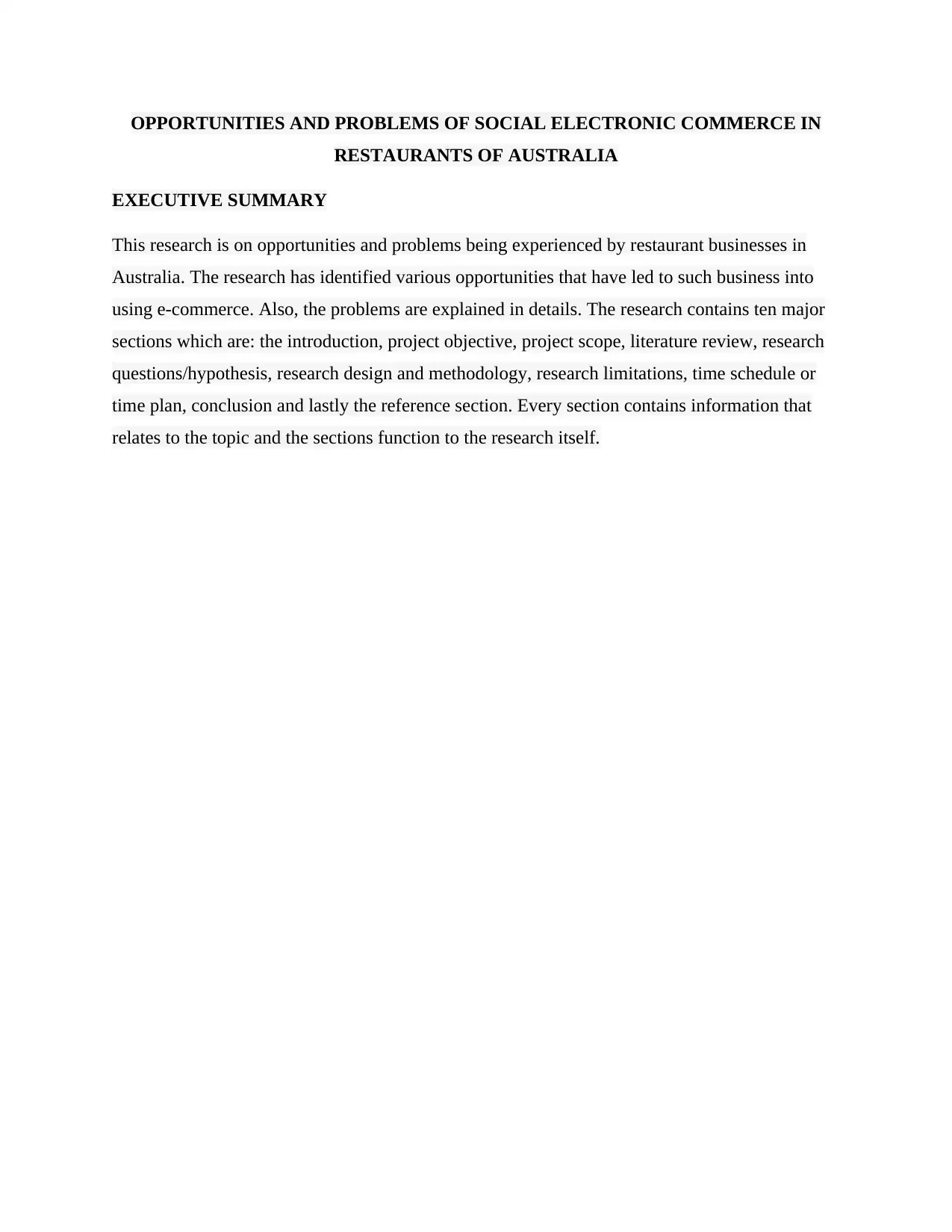
OPPORTUNITIES AND PROBLEMS OF SOCIAL ELECTRONIC COMMERCE IN
RESTAURANTS OF AUSTRALIA
EXECUTIVE SUMMARY
This research is on opportunities and problems being experienced by restaurant businesses in
Australia. The research has identified various opportunities that have led to such business into
using e-commerce. Also, the problems are explained in details. The research contains ten major
sections which are: the introduction, project objective, project scope, literature review, research
questions/hypothesis, research design and methodology, research limitations, time schedule or
time plan, conclusion and lastly the reference section. Every section contains information that
relates to the topic and the sections function to the research itself.
RESTAURANTS OF AUSTRALIA
EXECUTIVE SUMMARY
This research is on opportunities and problems being experienced by restaurant businesses in
Australia. The research has identified various opportunities that have led to such business into
using e-commerce. Also, the problems are explained in details. The research contains ten major
sections which are: the introduction, project objective, project scope, literature review, research
questions/hypothesis, research design and methodology, research limitations, time schedule or
time plan, conclusion and lastly the reference section. Every section contains information that
relates to the topic and the sections function to the research itself.
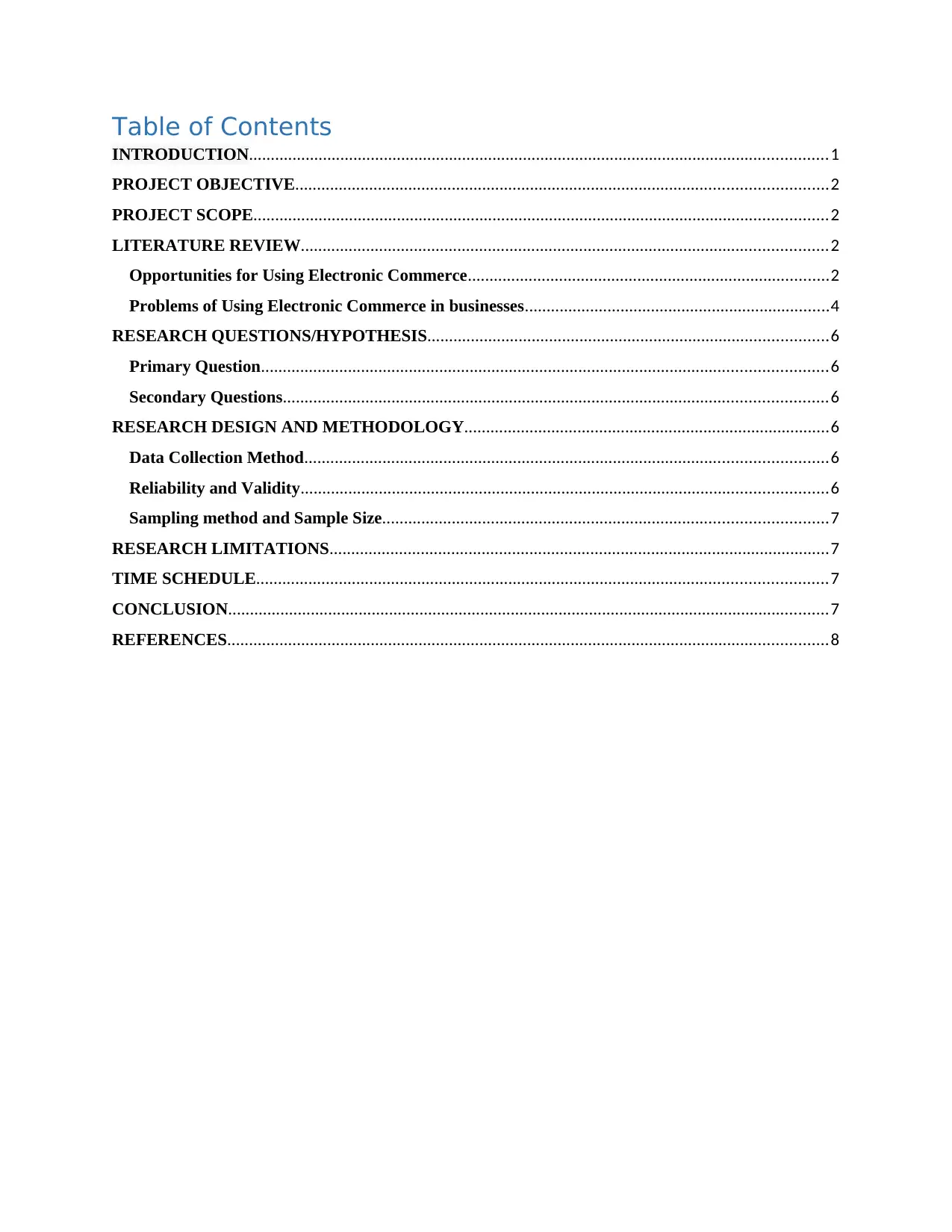
Table of Contents
INTRODUCTION.....................................................................................................................................1
PROJECT OBJECTIVE..........................................................................................................................2
PROJECT SCOPE....................................................................................................................................2
LITERATURE REVIEW.........................................................................................................................2
Opportunities for Using Electronic Commerce...................................................................................2
Problems of Using Electronic Commerce in businesses......................................................................4
RESEARCH QUESTIONS/HYPOTHESIS............................................................................................6
Primary Question..................................................................................................................................6
Secondary Questions.............................................................................................................................6
RESEARCH DESIGN AND METHODOLOGY....................................................................................6
Data Collection Method........................................................................................................................6
Reliability and Validity.........................................................................................................................6
Sampling method and Sample Size......................................................................................................7
RESEARCH LIMITATIONS...................................................................................................................7
TIME SCHEDULE...................................................................................................................................7
CONCLUSION..........................................................................................................................................7
REFERENCES..........................................................................................................................................8
INTRODUCTION.....................................................................................................................................1
PROJECT OBJECTIVE..........................................................................................................................2
PROJECT SCOPE....................................................................................................................................2
LITERATURE REVIEW.........................................................................................................................2
Opportunities for Using Electronic Commerce...................................................................................2
Problems of Using Electronic Commerce in businesses......................................................................4
RESEARCH QUESTIONS/HYPOTHESIS............................................................................................6
Primary Question..................................................................................................................................6
Secondary Questions.............................................................................................................................6
RESEARCH DESIGN AND METHODOLOGY....................................................................................6
Data Collection Method........................................................................................................................6
Reliability and Validity.........................................................................................................................6
Sampling method and Sample Size......................................................................................................7
RESEARCH LIMITATIONS...................................................................................................................7
TIME SCHEDULE...................................................................................................................................7
CONCLUSION..........................................................................................................................................7
REFERENCES..........................................................................................................................................8
⊘ This is a preview!⊘
Do you want full access?
Subscribe today to unlock all pages.

Trusted by 1+ million students worldwide
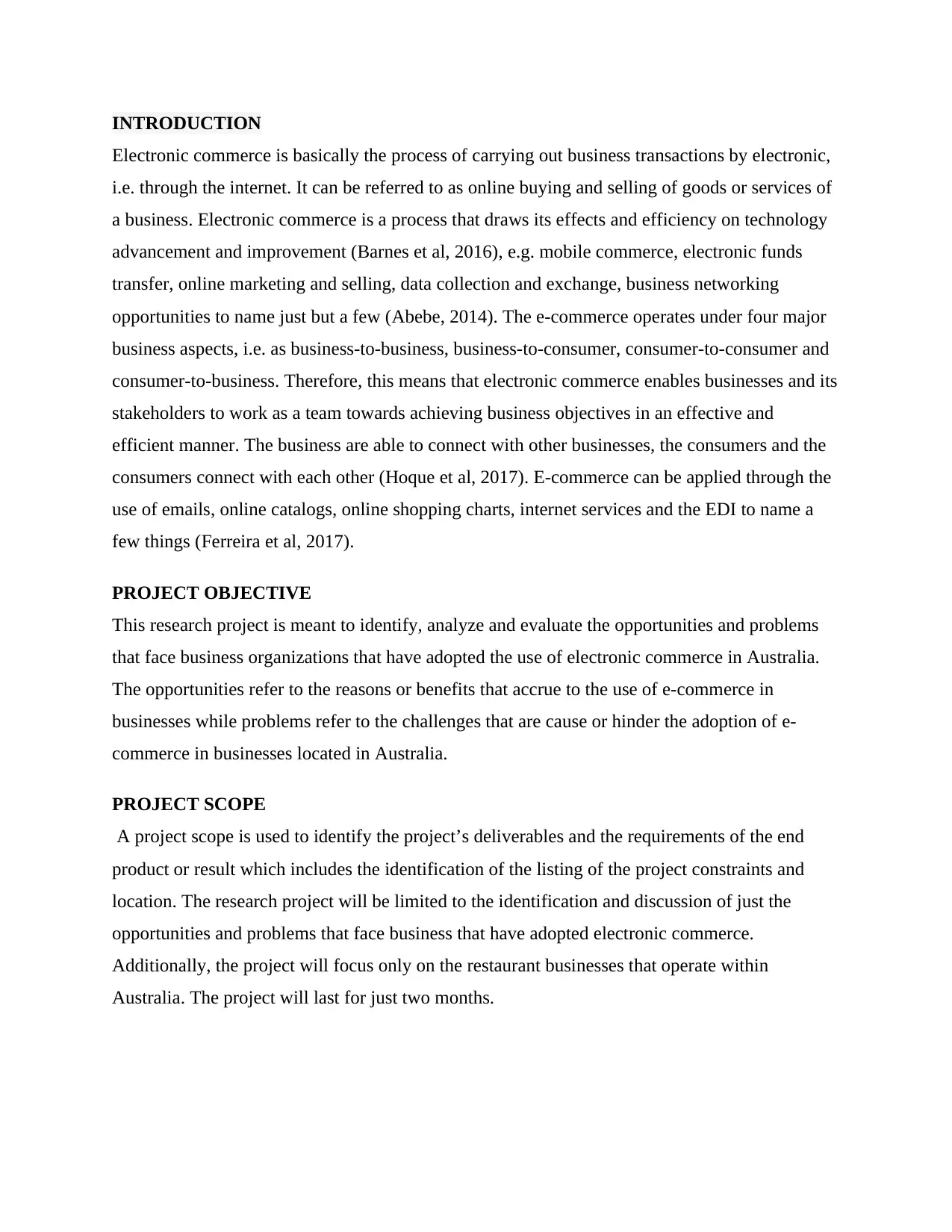
INTRODUCTION
Electronic commerce is basically the process of carrying out business transactions by electronic,
i.e. through the internet. It can be referred to as online buying and selling of goods or services of
a business. Electronic commerce is a process that draws its effects and efficiency on technology
advancement and improvement (Barnes et al, 2016), e.g. mobile commerce, electronic funds
transfer, online marketing and selling, data collection and exchange, business networking
opportunities to name just but a few (Abebe, 2014). The e-commerce operates under four major
business aspects, i.e. as business-to-business, business-to-consumer, consumer-to-consumer and
consumer-to-business. Therefore, this means that electronic commerce enables businesses and its
stakeholders to work as a team towards achieving business objectives in an effective and
efficient manner. The business are able to connect with other businesses, the consumers and the
consumers connect with each other (Hoque et al, 2017). E-commerce can be applied through the
use of emails, online catalogs, online shopping charts, internet services and the EDI to name a
few things (Ferreira et al, 2017).
PROJECT OBJECTIVE
This research project is meant to identify, analyze and evaluate the opportunities and problems
that face business organizations that have adopted the use of electronic commerce in Australia.
The opportunities refer to the reasons or benefits that accrue to the use of e-commerce in
businesses while problems refer to the challenges that are cause or hinder the adoption of e-
commerce in businesses located in Australia.
PROJECT SCOPE
A project scope is used to identify the project’s deliverables and the requirements of the end
product or result which includes the identification of the listing of the project constraints and
location. The research project will be limited to the identification and discussion of just the
opportunities and problems that face business that have adopted electronic commerce.
Additionally, the project will focus only on the restaurant businesses that operate within
Australia. The project will last for just two months.
Electronic commerce is basically the process of carrying out business transactions by electronic,
i.e. through the internet. It can be referred to as online buying and selling of goods or services of
a business. Electronic commerce is a process that draws its effects and efficiency on technology
advancement and improvement (Barnes et al, 2016), e.g. mobile commerce, electronic funds
transfer, online marketing and selling, data collection and exchange, business networking
opportunities to name just but a few (Abebe, 2014). The e-commerce operates under four major
business aspects, i.e. as business-to-business, business-to-consumer, consumer-to-consumer and
consumer-to-business. Therefore, this means that electronic commerce enables businesses and its
stakeholders to work as a team towards achieving business objectives in an effective and
efficient manner. The business are able to connect with other businesses, the consumers and the
consumers connect with each other (Hoque et al, 2017). E-commerce can be applied through the
use of emails, online catalogs, online shopping charts, internet services and the EDI to name a
few things (Ferreira et al, 2017).
PROJECT OBJECTIVE
This research project is meant to identify, analyze and evaluate the opportunities and problems
that face business organizations that have adopted the use of electronic commerce in Australia.
The opportunities refer to the reasons or benefits that accrue to the use of e-commerce in
businesses while problems refer to the challenges that are cause or hinder the adoption of e-
commerce in businesses located in Australia.
PROJECT SCOPE
A project scope is used to identify the project’s deliverables and the requirements of the end
product or result which includes the identification of the listing of the project constraints and
location. The research project will be limited to the identification and discussion of just the
opportunities and problems that face business that have adopted electronic commerce.
Additionally, the project will focus only on the restaurant businesses that operate within
Australia. The project will last for just two months.
Paraphrase This Document
Need a fresh take? Get an instant paraphrase of this document with our AI Paraphraser
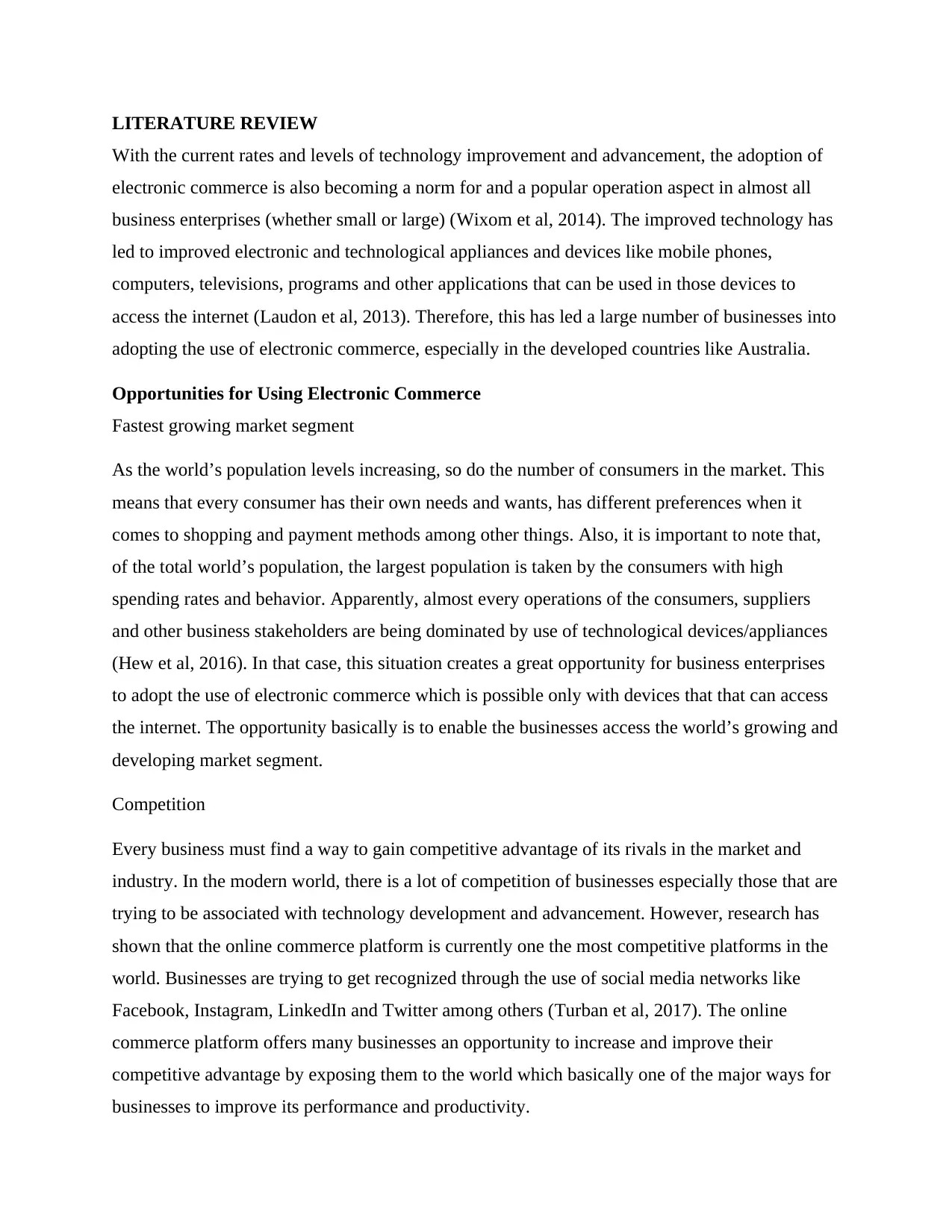
LITERATURE REVIEW
With the current rates and levels of technology improvement and advancement, the adoption of
electronic commerce is also becoming a norm for and a popular operation aspect in almost all
business enterprises (whether small or large) (Wixom et al, 2014). The improved technology has
led to improved electronic and technological appliances and devices like mobile phones,
computers, televisions, programs and other applications that can be used in those devices to
access the internet (Laudon et al, 2013). Therefore, this has led a large number of businesses into
adopting the use of electronic commerce, especially in the developed countries like Australia.
Opportunities for Using Electronic Commerce
Fastest growing market segment
As the world’s population levels increasing, so do the number of consumers in the market. This
means that every consumer has their own needs and wants, has different preferences when it
comes to shopping and payment methods among other things. Also, it is important to note that,
of the total world’s population, the largest population is taken by the consumers with high
spending rates and behavior. Apparently, almost every operations of the consumers, suppliers
and other business stakeholders are being dominated by use of technological devices/appliances
(Hew et al, 2016). In that case, this situation creates a great opportunity for business enterprises
to adopt the use of electronic commerce which is possible only with devices that that can access
the internet. The opportunity basically is to enable the businesses access the world’s growing and
developing market segment.
Competition
Every business must find a way to gain competitive advantage of its rivals in the market and
industry. In the modern world, there is a lot of competition of businesses especially those that are
trying to be associated with technology development and advancement. However, research has
shown that the online commerce platform is currently one the most competitive platforms in the
world. Businesses are trying to get recognized through the use of social media networks like
Facebook, Instagram, LinkedIn and Twitter among others (Turban et al, 2017). The online
commerce platform offers many businesses an opportunity to increase and improve their
competitive advantage by exposing them to the world which basically one of the major ways for
businesses to improve its performance and productivity.
With the current rates and levels of technology improvement and advancement, the adoption of
electronic commerce is also becoming a norm for and a popular operation aspect in almost all
business enterprises (whether small or large) (Wixom et al, 2014). The improved technology has
led to improved electronic and technological appliances and devices like mobile phones,
computers, televisions, programs and other applications that can be used in those devices to
access the internet (Laudon et al, 2013). Therefore, this has led a large number of businesses into
adopting the use of electronic commerce, especially in the developed countries like Australia.
Opportunities for Using Electronic Commerce
Fastest growing market segment
As the world’s population levels increasing, so do the number of consumers in the market. This
means that every consumer has their own needs and wants, has different preferences when it
comes to shopping and payment methods among other things. Also, it is important to note that,
of the total world’s population, the largest population is taken by the consumers with high
spending rates and behavior. Apparently, almost every operations of the consumers, suppliers
and other business stakeholders are being dominated by use of technological devices/appliances
(Hew et al, 2016). In that case, this situation creates a great opportunity for business enterprises
to adopt the use of electronic commerce which is possible only with devices that that can access
the internet. The opportunity basically is to enable the businesses access the world’s growing and
developing market segment.
Competition
Every business must find a way to gain competitive advantage of its rivals in the market and
industry. In the modern world, there is a lot of competition of businesses especially those that are
trying to be associated with technology development and advancement. However, research has
shown that the online commerce platform is currently one the most competitive platforms in the
world. Businesses are trying to get recognized through the use of social media networks like
Facebook, Instagram, LinkedIn and Twitter among others (Turban et al, 2017). The online
commerce platform offers many businesses an opportunity to increase and improve their
competitive advantage by exposing them to the world which basically one of the major ways for
businesses to improve its performance and productivity.
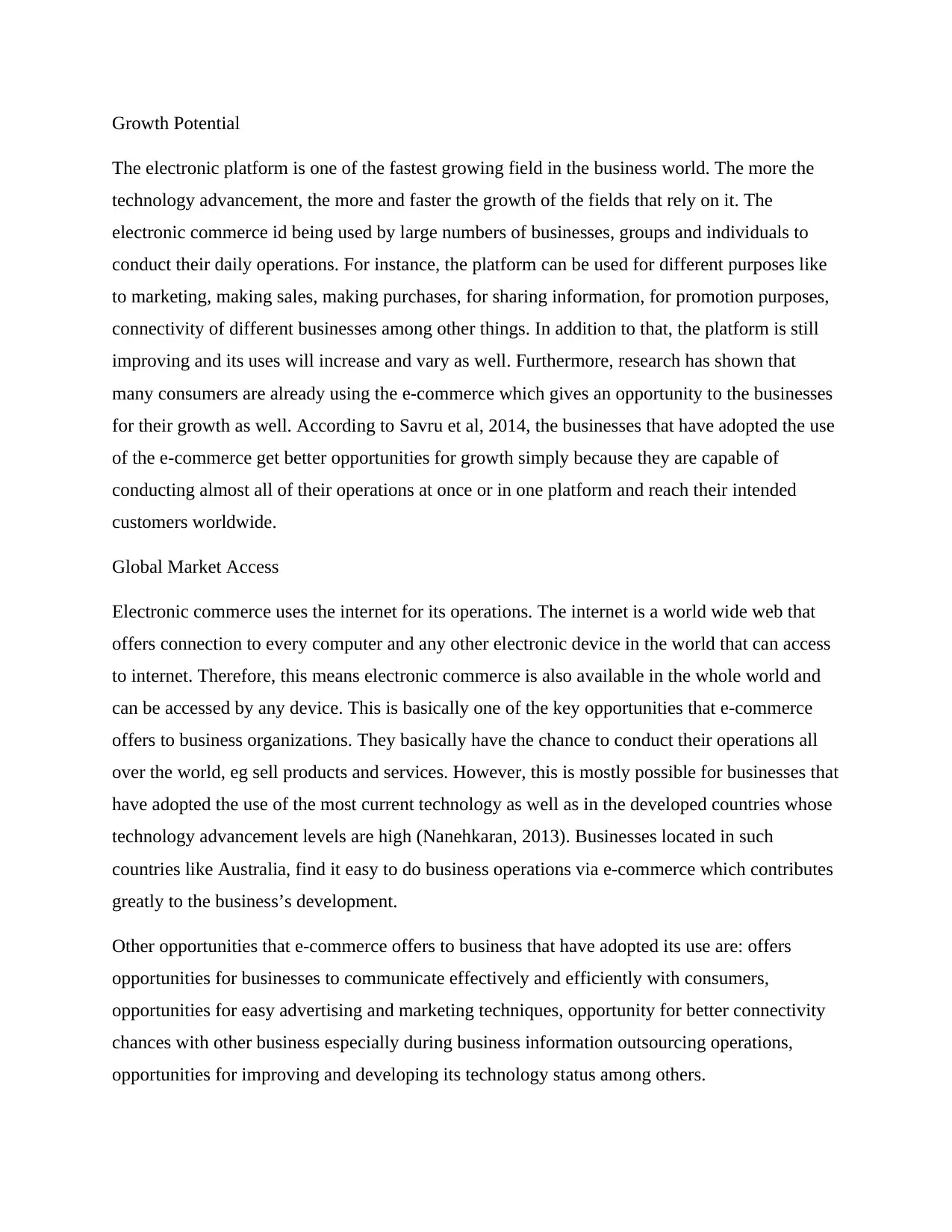
Growth Potential
The electronic platform is one of the fastest growing field in the business world. The more the
technology advancement, the more and faster the growth of the fields that rely on it. The
electronic commerce id being used by large numbers of businesses, groups and individuals to
conduct their daily operations. For instance, the platform can be used for different purposes like
to marketing, making sales, making purchases, for sharing information, for promotion purposes,
connectivity of different businesses among other things. In addition to that, the platform is still
improving and its uses will increase and vary as well. Furthermore, research has shown that
many consumers are already using the e-commerce which gives an opportunity to the businesses
for their growth as well. According to Savru et al, 2014, the businesses that have adopted the use
of the e-commerce get better opportunities for growth simply because they are capable of
conducting almost all of their operations at once or in one platform and reach their intended
customers worldwide.
Global Market Access
Electronic commerce uses the internet for its operations. The internet is a world wide web that
offers connection to every computer and any other electronic device in the world that can access
to internet. Therefore, this means electronic commerce is also available in the whole world and
can be accessed by any device. This is basically one of the key opportunities that e-commerce
offers to business organizations. They basically have the chance to conduct their operations all
over the world, eg sell products and services. However, this is mostly possible for businesses that
have adopted the use of the most current technology as well as in the developed countries whose
technology advancement levels are high (Nanehkaran, 2013). Businesses located in such
countries like Australia, find it easy to do business operations via e-commerce which contributes
greatly to the business’s development.
Other opportunities that e-commerce offers to business that have adopted its use are: offers
opportunities for businesses to communicate effectively and efficiently with consumers,
opportunities for easy advertising and marketing techniques, opportunity for better connectivity
chances with other business especially during business information outsourcing operations,
opportunities for improving and developing its technology status among others.
The electronic platform is one of the fastest growing field in the business world. The more the
technology advancement, the more and faster the growth of the fields that rely on it. The
electronic commerce id being used by large numbers of businesses, groups and individuals to
conduct their daily operations. For instance, the platform can be used for different purposes like
to marketing, making sales, making purchases, for sharing information, for promotion purposes,
connectivity of different businesses among other things. In addition to that, the platform is still
improving and its uses will increase and vary as well. Furthermore, research has shown that
many consumers are already using the e-commerce which gives an opportunity to the businesses
for their growth as well. According to Savru et al, 2014, the businesses that have adopted the use
of the e-commerce get better opportunities for growth simply because they are capable of
conducting almost all of their operations at once or in one platform and reach their intended
customers worldwide.
Global Market Access
Electronic commerce uses the internet for its operations. The internet is a world wide web that
offers connection to every computer and any other electronic device in the world that can access
to internet. Therefore, this means electronic commerce is also available in the whole world and
can be accessed by any device. This is basically one of the key opportunities that e-commerce
offers to business organizations. They basically have the chance to conduct their operations all
over the world, eg sell products and services. However, this is mostly possible for businesses that
have adopted the use of the most current technology as well as in the developed countries whose
technology advancement levels are high (Nanehkaran, 2013). Businesses located in such
countries like Australia, find it easy to do business operations via e-commerce which contributes
greatly to the business’s development.
Other opportunities that e-commerce offers to business that have adopted its use are: offers
opportunities for businesses to communicate effectively and efficiently with consumers,
opportunities for easy advertising and marketing techniques, opportunity for better connectivity
chances with other business especially during business information outsourcing operations,
opportunities for improving and developing its technology status among others.
⊘ This is a preview!⊘
Do you want full access?
Subscribe today to unlock all pages.

Trusted by 1+ million students worldwide
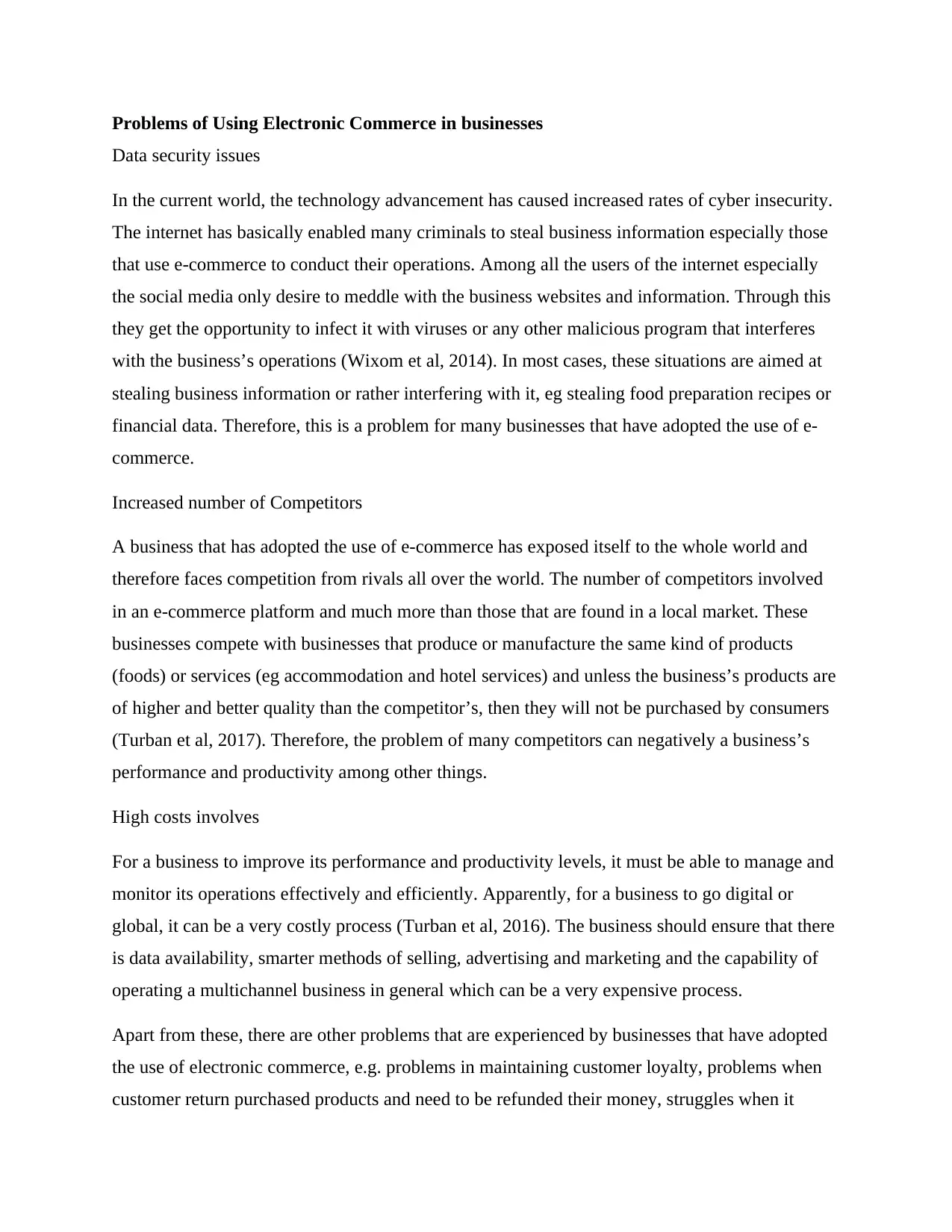
Problems of Using Electronic Commerce in businesses
Data security issues
In the current world, the technology advancement has caused increased rates of cyber insecurity.
The internet has basically enabled many criminals to steal business information especially those
that use e-commerce to conduct their operations. Among all the users of the internet especially
the social media only desire to meddle with the business websites and information. Through this
they get the opportunity to infect it with viruses or any other malicious program that interferes
with the business’s operations (Wixom et al, 2014). In most cases, these situations are aimed at
stealing business information or rather interfering with it, eg stealing food preparation recipes or
financial data. Therefore, this is a problem for many businesses that have adopted the use of e-
commerce.
Increased number of Competitors
A business that has adopted the use of e-commerce has exposed itself to the whole world and
therefore faces competition from rivals all over the world. The number of competitors involved
in an e-commerce platform and much more than those that are found in a local market. These
businesses compete with businesses that produce or manufacture the same kind of products
(foods) or services (eg accommodation and hotel services) and unless the business’s products are
of higher and better quality than the competitor’s, then they will not be purchased by consumers
(Turban et al, 2017). Therefore, the problem of many competitors can negatively a business’s
performance and productivity among other things.
High costs involves
For a business to improve its performance and productivity levels, it must be able to manage and
monitor its operations effectively and efficiently. Apparently, for a business to go digital or
global, it can be a very costly process (Turban et al, 2016). The business should ensure that there
is data availability, smarter methods of selling, advertising and marketing and the capability of
operating a multichannel business in general which can be a very expensive process.
Apart from these, there are other problems that are experienced by businesses that have adopted
the use of electronic commerce, e.g. problems in maintaining customer loyalty, problems when
customer return purchased products and need to be refunded their money, struggles when it
Data security issues
In the current world, the technology advancement has caused increased rates of cyber insecurity.
The internet has basically enabled many criminals to steal business information especially those
that use e-commerce to conduct their operations. Among all the users of the internet especially
the social media only desire to meddle with the business websites and information. Through this
they get the opportunity to infect it with viruses or any other malicious program that interferes
with the business’s operations (Wixom et al, 2014). In most cases, these situations are aimed at
stealing business information or rather interfering with it, eg stealing food preparation recipes or
financial data. Therefore, this is a problem for many businesses that have adopted the use of e-
commerce.
Increased number of Competitors
A business that has adopted the use of e-commerce has exposed itself to the whole world and
therefore faces competition from rivals all over the world. The number of competitors involved
in an e-commerce platform and much more than those that are found in a local market. These
businesses compete with businesses that produce or manufacture the same kind of products
(foods) or services (eg accommodation and hotel services) and unless the business’s products are
of higher and better quality than the competitor’s, then they will not be purchased by consumers
(Turban et al, 2017). Therefore, the problem of many competitors can negatively a business’s
performance and productivity among other things.
High costs involves
For a business to improve its performance and productivity levels, it must be able to manage and
monitor its operations effectively and efficiently. Apparently, for a business to go digital or
global, it can be a very costly process (Turban et al, 2016). The business should ensure that there
is data availability, smarter methods of selling, advertising and marketing and the capability of
operating a multichannel business in general which can be a very expensive process.
Apart from these, there are other problems that are experienced by businesses that have adopted
the use of electronic commerce, e.g. problems in maintaining customer loyalty, problems when
customer return purchased products and need to be refunded their money, struggles when it
Paraphrase This Document
Need a fresh take? Get an instant paraphrase of this document with our AI Paraphraser
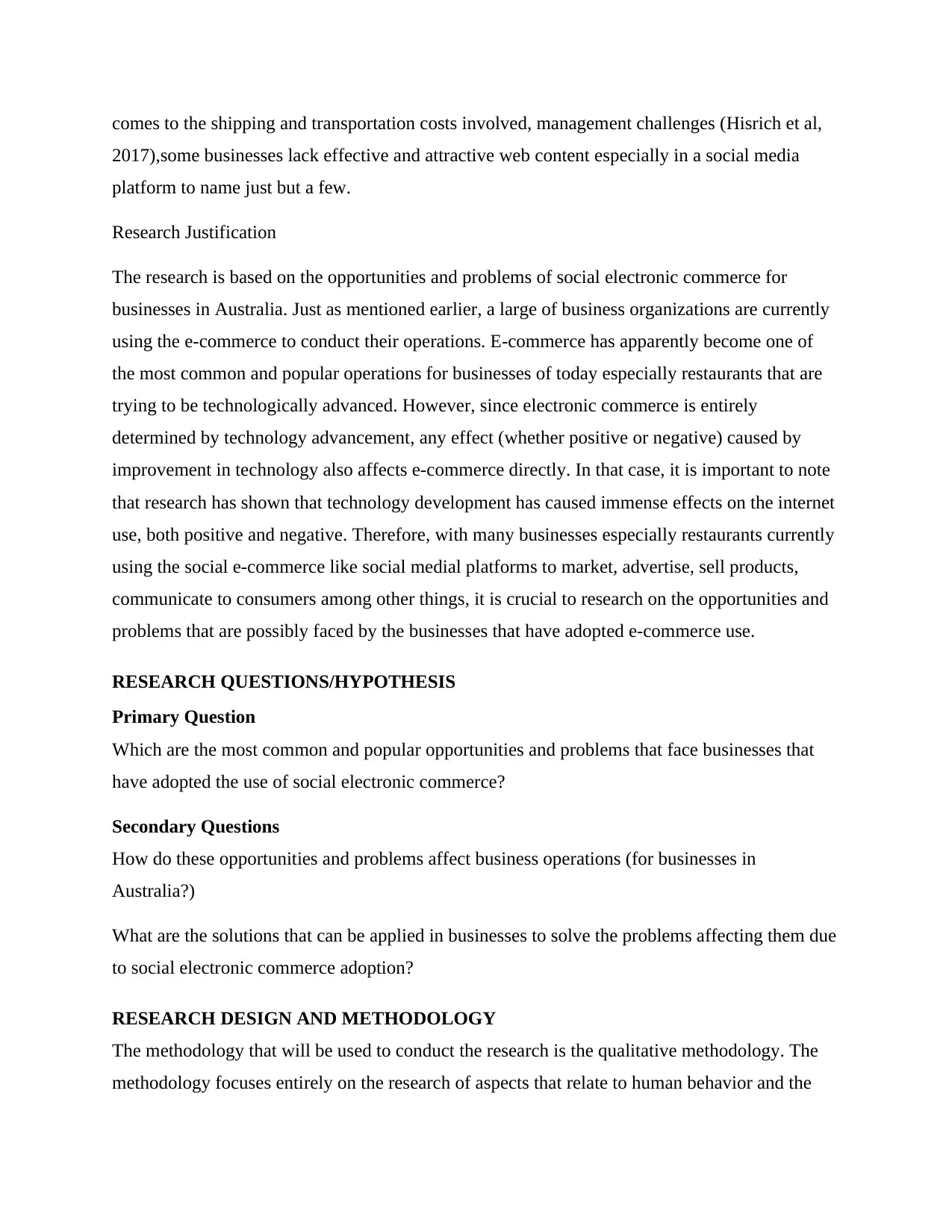
comes to the shipping and transportation costs involved, management challenges (Hisrich et al,
2017),some businesses lack effective and attractive web content especially in a social media
platform to name just but a few.
Research Justification
The research is based on the opportunities and problems of social electronic commerce for
businesses in Australia. Just as mentioned earlier, a large of business organizations are currently
using the e-commerce to conduct their operations. E-commerce has apparently become one of
the most common and popular operations for businesses of today especially restaurants that are
trying to be technologically advanced. However, since electronic commerce is entirely
determined by technology advancement, any effect (whether positive or negative) caused by
improvement in technology also affects e-commerce directly. In that case, it is important to note
that research has shown that technology development has caused immense effects on the internet
use, both positive and negative. Therefore, with many businesses especially restaurants currently
using the social e-commerce like social medial platforms to market, advertise, sell products,
communicate to consumers among other things, it is crucial to research on the opportunities and
problems that are possibly faced by the businesses that have adopted e-commerce use.
RESEARCH QUESTIONS/HYPOTHESIS
Primary Question
Which are the most common and popular opportunities and problems that face businesses that
have adopted the use of social electronic commerce?
Secondary Questions
How do these opportunities and problems affect business operations (for businesses in
Australia?)
What are the solutions that can be applied in businesses to solve the problems affecting them due
to social electronic commerce adoption?
RESEARCH DESIGN AND METHODOLOGY
The methodology that will be used to conduct the research is the qualitative methodology. The
methodology focuses entirely on the research of aspects that relate to human behavior and the
2017),some businesses lack effective and attractive web content especially in a social media
platform to name just but a few.
Research Justification
The research is based on the opportunities and problems of social electronic commerce for
businesses in Australia. Just as mentioned earlier, a large of business organizations are currently
using the e-commerce to conduct their operations. E-commerce has apparently become one of
the most common and popular operations for businesses of today especially restaurants that are
trying to be technologically advanced. However, since electronic commerce is entirely
determined by technology advancement, any effect (whether positive or negative) caused by
improvement in technology also affects e-commerce directly. In that case, it is important to note
that research has shown that technology development has caused immense effects on the internet
use, both positive and negative. Therefore, with many businesses especially restaurants currently
using the social e-commerce like social medial platforms to market, advertise, sell products,
communicate to consumers among other things, it is crucial to research on the opportunities and
problems that are possibly faced by the businesses that have adopted e-commerce use.
RESEARCH QUESTIONS/HYPOTHESIS
Primary Question
Which are the most common and popular opportunities and problems that face businesses that
have adopted the use of social electronic commerce?
Secondary Questions
How do these opportunities and problems affect business operations (for businesses in
Australia?)
What are the solutions that can be applied in businesses to solve the problems affecting them due
to social electronic commerce adoption?
RESEARCH DESIGN AND METHODOLOGY
The methodology that will be used to conduct the research is the qualitative methodology. The
methodology focuses entirely on the research of aspects that relate to human behavior and the
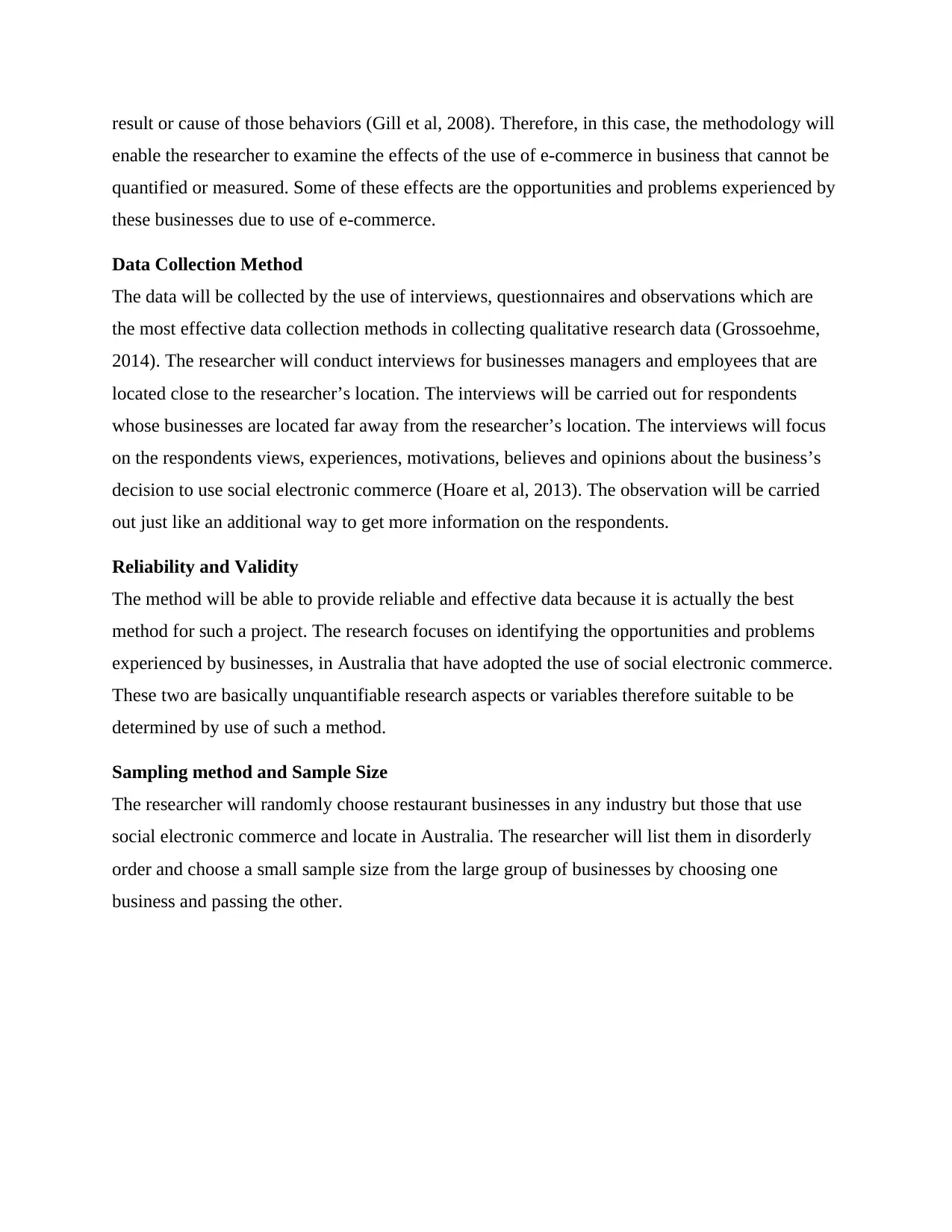
result or cause of those behaviors (Gill et al, 2008). Therefore, in this case, the methodology will
enable the researcher to examine the effects of the use of e-commerce in business that cannot be
quantified or measured. Some of these effects are the opportunities and problems experienced by
these businesses due to use of e-commerce.
Data Collection Method
The data will be collected by the use of interviews, questionnaires and observations which are
the most effective data collection methods in collecting qualitative research data (Grossoehme,
2014). The researcher will conduct interviews for businesses managers and employees that are
located close to the researcher’s location. The interviews will be carried out for respondents
whose businesses are located far away from the researcher’s location. The interviews will focus
on the respondents views, experiences, motivations, believes and opinions about the business’s
decision to use social electronic commerce (Hoare et al, 2013). The observation will be carried
out just like an additional way to get more information on the respondents.
Reliability and Validity
The method will be able to provide reliable and effective data because it is actually the best
method for such a project. The research focuses on identifying the opportunities and problems
experienced by businesses, in Australia that have adopted the use of social electronic commerce.
These two are basically unquantifiable research aspects or variables therefore suitable to be
determined by use of such a method.
Sampling method and Sample Size
The researcher will randomly choose restaurant businesses in any industry but those that use
social electronic commerce and locate in Australia. The researcher will list them in disorderly
order and choose a small sample size from the large group of businesses by choosing one
business and passing the other.
enable the researcher to examine the effects of the use of e-commerce in business that cannot be
quantified or measured. Some of these effects are the opportunities and problems experienced by
these businesses due to use of e-commerce.
Data Collection Method
The data will be collected by the use of interviews, questionnaires and observations which are
the most effective data collection methods in collecting qualitative research data (Grossoehme,
2014). The researcher will conduct interviews for businesses managers and employees that are
located close to the researcher’s location. The interviews will be carried out for respondents
whose businesses are located far away from the researcher’s location. The interviews will focus
on the respondents views, experiences, motivations, believes and opinions about the business’s
decision to use social electronic commerce (Hoare et al, 2013). The observation will be carried
out just like an additional way to get more information on the respondents.
Reliability and Validity
The method will be able to provide reliable and effective data because it is actually the best
method for such a project. The research focuses on identifying the opportunities and problems
experienced by businesses, in Australia that have adopted the use of social electronic commerce.
These two are basically unquantifiable research aspects or variables therefore suitable to be
determined by use of such a method.
Sampling method and Sample Size
The researcher will randomly choose restaurant businesses in any industry but those that use
social electronic commerce and locate in Australia. The researcher will list them in disorderly
order and choose a small sample size from the large group of businesses by choosing one
business and passing the other.
⊘ This is a preview!⊘
Do you want full access?
Subscribe today to unlock all pages.

Trusted by 1+ million students worldwide
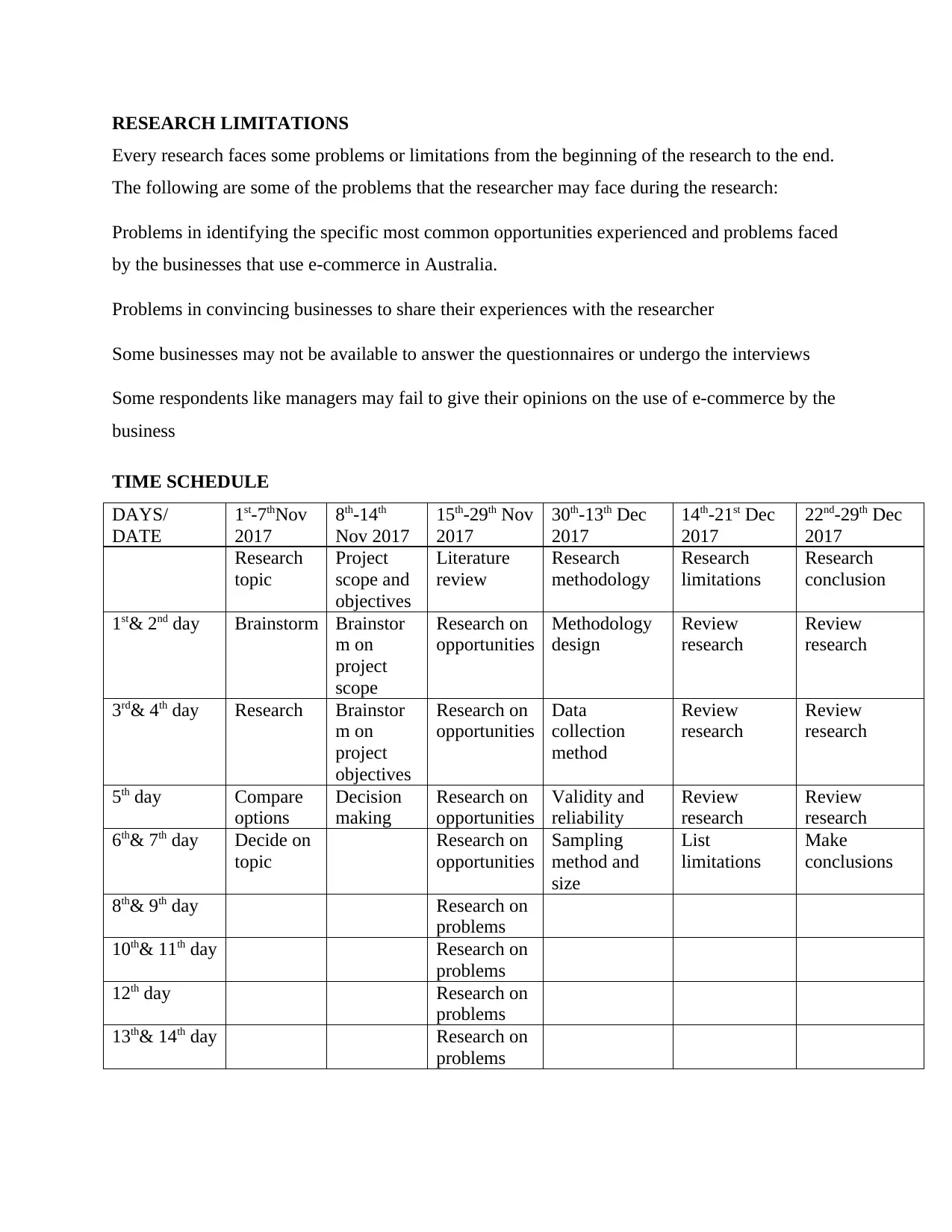
RESEARCH LIMITATIONS
Every research faces some problems or limitations from the beginning of the research to the end.
The following are some of the problems that the researcher may face during the research:
Problems in identifying the specific most common opportunities experienced and problems faced
by the businesses that use e-commerce in Australia.
Problems in convincing businesses to share their experiences with the researcher
Some businesses may not be available to answer the questionnaires or undergo the interviews
Some respondents like managers may fail to give their opinions on the use of e-commerce by the
business
TIME SCHEDULE
DAYS/
DATE
1st-7thNov
2017
8th-14th
Nov 2017
15th-29th Nov
2017
30th-13th Dec
2017
14th-21st Dec
2017
22nd-29th Dec
2017
Research
topic
Project
scope and
objectives
Literature
review
Research
methodology
Research
limitations
Research
conclusion
1st& 2nd day Brainstorm Brainstor
m on
project
scope
Research on
opportunities
Methodology
design
Review
research
Review
research
3rd& 4th day Research Brainstor
m on
project
objectives
Research on
opportunities
Data
collection
method
Review
research
Review
research
5th day Compare
options
Decision
making
Research on
opportunities
Validity and
reliability
Review
research
Review
research
6th& 7th day Decide on
topic
Research on
opportunities
Sampling
method and
size
List
limitations
Make
conclusions
8th& 9th day Research on
problems
10th& 11th day Research on
problems
12th day Research on
problems
13th& 14th day Research on
problems
Every research faces some problems or limitations from the beginning of the research to the end.
The following are some of the problems that the researcher may face during the research:
Problems in identifying the specific most common opportunities experienced and problems faced
by the businesses that use e-commerce in Australia.
Problems in convincing businesses to share their experiences with the researcher
Some businesses may not be available to answer the questionnaires or undergo the interviews
Some respondents like managers may fail to give their opinions on the use of e-commerce by the
business
TIME SCHEDULE
DAYS/
DATE
1st-7thNov
2017
8th-14th
Nov 2017
15th-29th Nov
2017
30th-13th Dec
2017
14th-21st Dec
2017
22nd-29th Dec
2017
Research
topic
Project
scope and
objectives
Literature
review
Research
methodology
Research
limitations
Research
conclusion
1st& 2nd day Brainstorm Brainstor
m on
project
scope
Research on
opportunities
Methodology
design
Review
research
Review
research
3rd& 4th day Research Brainstor
m on
project
objectives
Research on
opportunities
Data
collection
method
Review
research
Review
research
5th day Compare
options
Decision
making
Research on
opportunities
Validity and
reliability
Review
research
Review
research
6th& 7th day Decide on
topic
Research on
opportunities
Sampling
method and
size
List
limitations
Make
conclusions
8th& 9th day Research on
problems
10th& 11th day Research on
problems
12th day Research on
problems
13th& 14th day Research on
problems
Paraphrase This Document
Need a fresh take? Get an instant paraphrase of this document with our AI Paraphraser
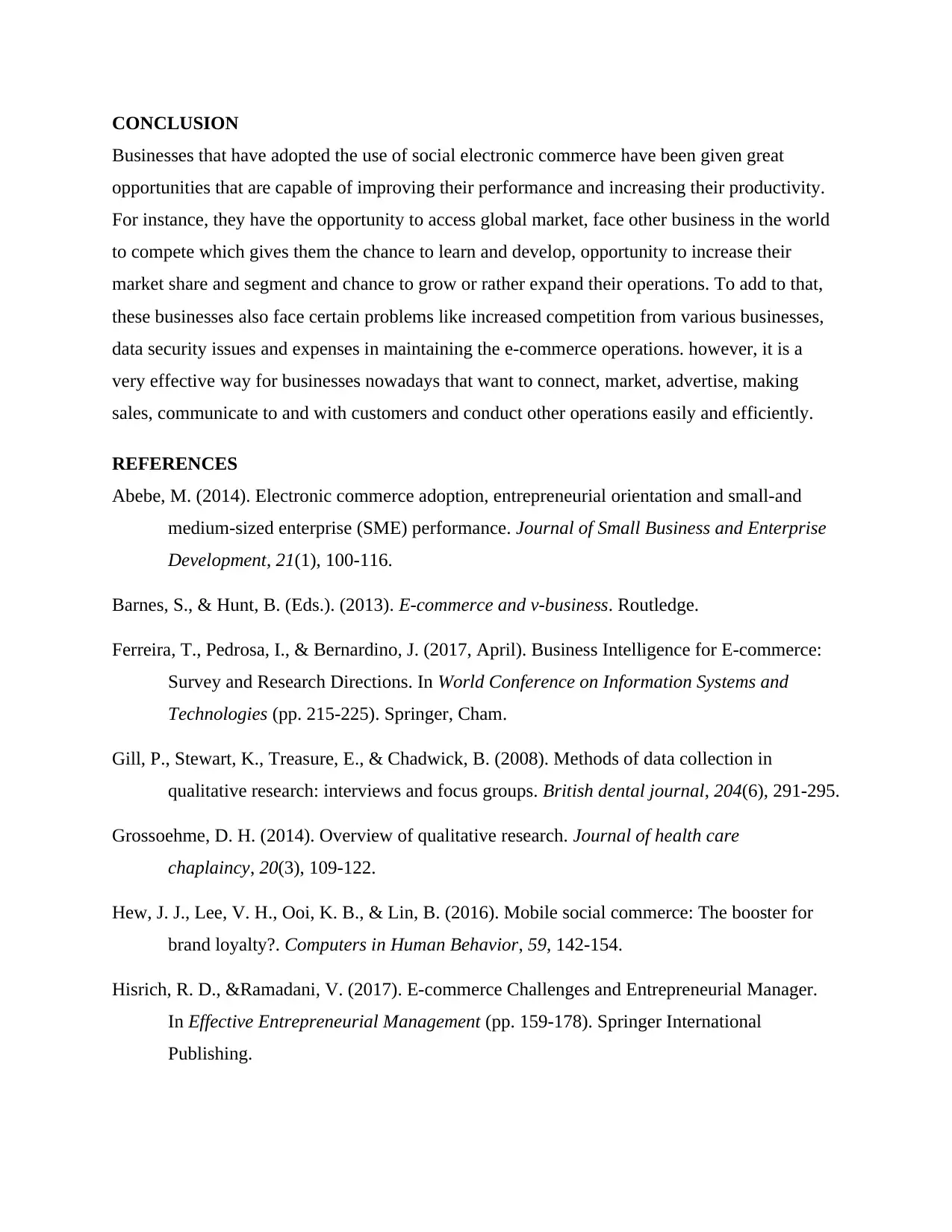
CONCLUSION
Businesses that have adopted the use of social electronic commerce have been given great
opportunities that are capable of improving their performance and increasing their productivity.
For instance, they have the opportunity to access global market, face other business in the world
to compete which gives them the chance to learn and develop, opportunity to increase their
market share and segment and chance to grow or rather expand their operations. To add to that,
these businesses also face certain problems like increased competition from various businesses,
data security issues and expenses in maintaining the e-commerce operations. however, it is a
very effective way for businesses nowadays that want to connect, market, advertise, making
sales, communicate to and with customers and conduct other operations easily and efficiently.
REFERENCES
Abebe, M. (2014). Electronic commerce adoption, entrepreneurial orientation and small-and
medium-sized enterprise (SME) performance. Journal of Small Business and Enterprise
Development, 21(1), 100-116.
Barnes, S., & Hunt, B. (Eds.). (2013). E-commerce and v-business. Routledge.
Ferreira, T., Pedrosa, I., & Bernardino, J. (2017, April). Business Intelligence for E-commerce:
Survey and Research Directions. In World Conference on Information Systems and
Technologies (pp. 215-225). Springer, Cham.
Gill, P., Stewart, K., Treasure, E., & Chadwick, B. (2008). Methods of data collection in
qualitative research: interviews and focus groups. British dental journal, 204(6), 291-295.
Grossoehme, D. H. (2014). Overview of qualitative research. Journal of health care
chaplaincy, 20(3), 109-122.
Hew, J. J., Lee, V. H., Ooi, K. B., & Lin, B. (2016). Mobile social commerce: The booster for
brand loyalty?. Computers in Human Behavior, 59, 142-154.
Hisrich, R. D., &Ramadani, V. (2017). E-commerce Challenges and Entrepreneurial Manager.
In Effective Entrepreneurial Management (pp. 159-178). Springer International
Publishing.
Businesses that have adopted the use of social electronic commerce have been given great
opportunities that are capable of improving their performance and increasing their productivity.
For instance, they have the opportunity to access global market, face other business in the world
to compete which gives them the chance to learn and develop, opportunity to increase their
market share and segment and chance to grow or rather expand their operations. To add to that,
these businesses also face certain problems like increased competition from various businesses,
data security issues and expenses in maintaining the e-commerce operations. however, it is a
very effective way for businesses nowadays that want to connect, market, advertise, making
sales, communicate to and with customers and conduct other operations easily and efficiently.
REFERENCES
Abebe, M. (2014). Electronic commerce adoption, entrepreneurial orientation and small-and
medium-sized enterprise (SME) performance. Journal of Small Business and Enterprise
Development, 21(1), 100-116.
Barnes, S., & Hunt, B. (Eds.). (2013). E-commerce and v-business. Routledge.
Ferreira, T., Pedrosa, I., & Bernardino, J. (2017, April). Business Intelligence for E-commerce:
Survey and Research Directions. In World Conference on Information Systems and
Technologies (pp. 215-225). Springer, Cham.
Gill, P., Stewart, K., Treasure, E., & Chadwick, B. (2008). Methods of data collection in
qualitative research: interviews and focus groups. British dental journal, 204(6), 291-295.
Grossoehme, D. H. (2014). Overview of qualitative research. Journal of health care
chaplaincy, 20(3), 109-122.
Hew, J. J., Lee, V. H., Ooi, K. B., & Lin, B. (2016). Mobile social commerce: The booster for
brand loyalty?. Computers in Human Behavior, 59, 142-154.
Hisrich, R. D., &Ramadani, V. (2017). E-commerce Challenges and Entrepreneurial Manager.
In Effective Entrepreneurial Management (pp. 159-178). Springer International
Publishing.

Hoare, Z., & Hoe, J. (2013). Understanding quantitative research: Part 2. Nursing
Standard, 27(18), 48-55.
Hoque, M. R., &Boateng, R. (2017). Adoption of B2B e-Commerce in Developing.
Laudon, K. C., &Traver, C. G. (2013). E-commerce. Pearson.
Nanehkaran, Y. A. (2013). An Introduction to electronic commerce. International Journal of
Scientific & Technology Research, 2(4), 190-193.
Savrul, M., Incekara, A., &Sener, S. (2014). The potential of e-commerce for SMEs in a
globalizing business environment. Procedia-Social and Behavioral Sciences, 150, 35-45.
Turban, E., Strauss, J., & Lai, L. (2016). The Social Enterprise: From Recruiting to Problem
Solving and Collaboration. In Social Commerce (pp. 181-203). Springer International
Publishing.
Turban, E., Whiteside, J., King, D., & Outland, J. (2017). Business-to-Business E-Commerce.
In Introduction to Electronic Commerce and Social Commerce (pp. 101-135). Springer
International Publishing.
Turban, E., Whiteside, J., King, D., & Outland, J. (2017). Overview of Electronic Commerce and
Social Commerce. In Introduction to Electronic Commerce and Social Commerce (pp. 3-
33). Springer International Publishing.
Wixom, B., Ariyachandra, T., Douglas, D. E., Goul, M., Gupta, B., Iyer, L. S., ...&Turetken, O.
(2014). The current state of business intelligence in academia: The arrival of big
data. CAIS, 34, 1.
Standard, 27(18), 48-55.
Hoque, M. R., &Boateng, R. (2017). Adoption of B2B e-Commerce in Developing.
Laudon, K. C., &Traver, C. G. (2013). E-commerce. Pearson.
Nanehkaran, Y. A. (2013). An Introduction to electronic commerce. International Journal of
Scientific & Technology Research, 2(4), 190-193.
Savrul, M., Incekara, A., &Sener, S. (2014). The potential of e-commerce for SMEs in a
globalizing business environment. Procedia-Social and Behavioral Sciences, 150, 35-45.
Turban, E., Strauss, J., & Lai, L. (2016). The Social Enterprise: From Recruiting to Problem
Solving and Collaboration. In Social Commerce (pp. 181-203). Springer International
Publishing.
Turban, E., Whiteside, J., King, D., & Outland, J. (2017). Business-to-Business E-Commerce.
In Introduction to Electronic Commerce and Social Commerce (pp. 101-135). Springer
International Publishing.
Turban, E., Whiteside, J., King, D., & Outland, J. (2017). Overview of Electronic Commerce and
Social Commerce. In Introduction to Electronic Commerce and Social Commerce (pp. 3-
33). Springer International Publishing.
Wixom, B., Ariyachandra, T., Douglas, D. E., Goul, M., Gupta, B., Iyer, L. S., ...&Turetken, O.
(2014). The current state of business intelligence in academia: The arrival of big
data. CAIS, 34, 1.
⊘ This is a preview!⊘
Do you want full access?
Subscribe today to unlock all pages.

Trusted by 1+ million students worldwide
1 out of 12
Related Documents
Your All-in-One AI-Powered Toolkit for Academic Success.
+13062052269
info@desklib.com
Available 24*7 on WhatsApp / Email
![[object Object]](/_next/static/media/star-bottom.7253800d.svg)
Unlock your academic potential
Copyright © 2020–2025 A2Z Services. All Rights Reserved. Developed and managed by ZUCOL.





